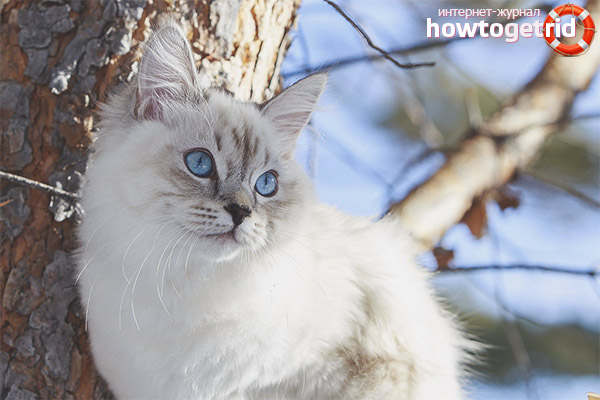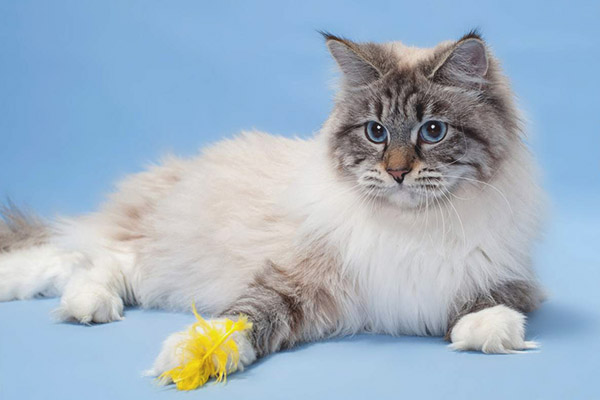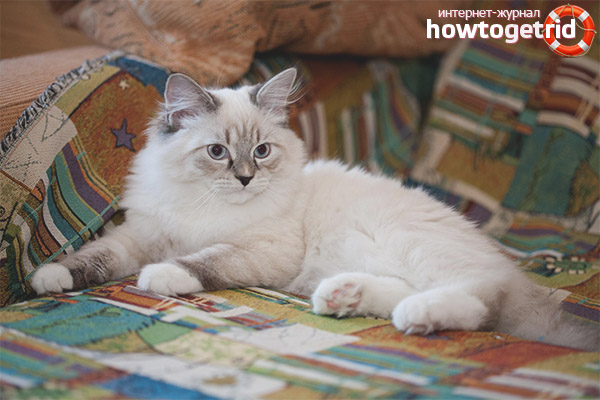The content of the article
For the first time this unusual cat appeared in St. Petersburg (at that time in Leningrad) purely by chance. The first born litter of these animals of unusual color was the fruit of sudden love between a handsome Russian Siberian and a Siamese cat. In normal cases, these mestizo are not paid much attention, but not this time - the unique color of one of the kittens immediately attracted the attention of the breeders of the time. The yard was in the winter of 1988, the time of perestroika, which resulted in a lot of different changes, among which became popular. organization of numerous exhibitions. It was the very first exhibition of representatives of the cat family, held in the open spaces of the USSR.At such events, in those days, the external beauty of the specimens presented was more likely to be evaluated than their genetic line ... Then everything just got its development. A small kitten from one of the organizers was presented as additional show mongrel specimens, but it was his unusual coloring that attracted the attention of experienced breeders and marked the beginning of the further development of the breed.
The Neva Masquerade cat received its official purebred status 4 years later - in 1992, in the same St. Petersburg, but already at an exhibition of international importance. And since then, her popularity has intensively begun to gain momentum.
External parameters and character of the breed
The first kittens appeared in a natural, natural way, one might say, even accidentally - a Siamese cat of one of the organizers of cat shows entered into a random mating with a Siberian cat. As a result of such an interesting crossing, a kitten was born that took the best qualities of both breeds from its father and mother:
- Powerful exterior, which allowed to carry the breed in the category of large domestic cats.
- An unusual color is at the same time a beige color of a fur coat and striped ringlets of different intensity, characteristic of a tiger color of Siberian cats.
- Sky blue eye color, characteristic of Siamese representatives.
The outward uniqueness struck connoisseurs of feline beauty, and soon the owner of an unusual kitten began to receive various offers concerning the further breeding of kittens and their further transformation into a separate breed.
For a long time, the Neva Masquerade was considered a genetic lead from the Siberian and Siamese breeds. However, recent cat shows held in different cities and countries more often began to present the Neva Masquerade as an independent breed that has its own distinct characteristics that help differentiate it from its original specimens:
- Larger body, clear beige color and blue eyes compared to Siberian cats.
- More fluffy undercoat, stylish tiger rings and not always monochromatic pattern of the face compared with Thai breeds.
- Persistent combined distribution of external signs in newly born kittens, allowing to distinguish this variation of cats in a separate breed.
The newly bred breed was more robust than its predecessors: it tolerated extreme weather changes better than her parents, she had the least allergic reactions, and the combination of two breeds made the animal less whimsical in food than Siamese beauties are usually different.
As development progressed, the character of the new Murka improved more and more. The characteristic rejection of kittens, which is sometimes noted among the representatives of the eastern breed - in this combination she preferred to inherit the Siberian genes, making the female gender of the Neva Masquerade beautiful mothers. Also, this breed, compared with the Thai specimens, is less vindictive and vindictive. From the great-grandfather-Siberian cats and cats of the Neva Masquerade inherited excellent hunting qualities, which they regularly demonstrate in the hunt for rodents, insects and fast-moving small objects.
Detailed description of the breed: appearance
- Head. The classical representatives of the Neva breed have a large trapezoid head.The standard has a broad rounded forehead, smoothly moving to the back of the nose. Wide powerful not outstanding chin. Cheeks tightly pressed.
- The ears are of medium size, acute angular in shape, widely spaced, and the distance between the two shells is larger than the dimensions of the shells themselves. In the breed, the advantages of getting exterior kittens, for example, with brushes on the ears.
- The eyeballs are round in shape, the eyes are set to medium-wide, slightly sloping due to the arcuate roundness of the upper eyelid. The lower eyelid has a classic rounded shape. The color of the iris is usually sky blue. But it can vary from gray-blue to deep blue. There are lavender, cornflower, sapphire shades. This is due to the genetics of the Siamese progenitor.
- Body. The exterior of the body of the Neva Masquerade is due to its unusual combination of stats and muscular strength directly to the eastern and Russian ancestors. The wide bone system, the long paws were presented to them by Siamese predecessors, and they owe their elongated physique and good muscular component to the domestic Siberian Murks and Murziesdirectly involved in strengthening the breed qualities. The body of the Neva Masquerade can be described with an almost perfect rectangle. Their strong strong paws are proportionally combined with a perfectly curved spine and keep a harmoniously distributed load well. The paws themselves at the ends can be lighter or darker than the usual tone of the body coat, between the fingers, as a rule, hair grows.
- The tail is expanded at the base, then as it grows it has the same thickness, and the tip usually has a rounded shape. It has a fluffy, usually feather-shaped form.
- The mass of an adult mature male can reach 7–9 kilograms, the females are somewhat smaller, their average weight is 5–6 kilograms.
Wool
Wool plays practically the leading role in the appearance of the breed, but, in addition to visual features, it also has its invaluable practical qualities. The hair of little kittens is little polluted, slightly wet and practically does not stray into mats.
In an adult cat, the length of the coat varies depending on the season and the climate in which the animals live.Thus, southern four-fingered women have a shorter length of woolen hairs than their counterparts in more northern regions. In addition, the length of the hair varies throughout the whole body: the longest hairs sprout from the shoulder blades and to the base of the front paws, and the shortest hairs on the muzzle. The structure of the side coat is usually somewhat softer than on the back and legs.
The Siberian variety of color-point has an unusual luxurious undercoat in the area of pants and collar area, which is practically lost during interseasonal moulting.
The sebaceous glands of the Neva Masquerade Cats practically do not secrete secretion, so that this cat is considered one of the most hypoallergenic varieties.
Wool coat color
At first glance, the color of the Neva Masquerade may seem “banal”, given the external features of the progenitors, however, in fact there is a wide variety of color combinations:
- Silver point or “seal color” is characterized by beige or gray-beige hues of body wool with a gradual easy care in a smoky or brown point on the paws.
- A red point is a combination of beige-colored wool on the main body with a transition to a bright red or fawn on the paws and the muzzle.
- A bluish point - implies a gradual shift of accents from beige or gray-beige to smoky tones.
- Tortoise Point - implies a fragmented cocktail of several colors and is genetically inherent only in females of the breed.
Most often, Neva masquerades with a silver point or silver hue to all other shades of wool are found.
If there are white socks or boots on the paws, then on the face, as a rule, there is a speck or "asterisk" of the same color. Breed does not imply a clear symmetry of the location of these components.
What types of errors are unacceptable for the breed:
- Chocolate lilac coat color.
- Excessive darkening on body coat.
- Disproportionate disproportion of the body.
- Small, far-set eyes.
- Eyes of different colors (for example, blue and yellow).
- Short rounded ears.
- Care of the eye color in the green or yellow side.
Character
Despite the truly considerable size, the Neva cat has a balanced and loyal character.The animal is able to become attached, and this attachment is not to the place of residence, but to people. Among households, the kitten quickly chooses its owner and, as a rule, is truly able to obey only him. Animals of this unique breed do not tolerate violence against their persona, as well as does not respect admiration for her. It should be clearly understood that this is a partner cat and relations with it should be built on the principle of equality.
Cats are very affectionate and sociable, they can purr for hours for a long time. They are not vindictive - this line was defeated by the genes of the Siberian great-grandfather.
It should be understood that this cat considers itself to be aristocracy - it is very friendly with children and practically does not accept strangers. No, she would not gang up and bite - aggression is not about her! She would prefer to retreat, hiding in a secluded high place.
Care for Neva Beauty
The content and hygiene measures defined for the Neva Masquerade cat are almost the same as for any other breed:
- Wool. There must be a special massage brush and a device for combing out the down.Among the means to wash you need to choose specialized gels or shampoos for cats (labeled "for long hair").
- It should be understood that due to its anatomical structure it is almost impossible to comb out the hair of the tail. It is important to carefully handle it, as randomly pulled out tufts of wool may not recover.
- Bathing cats recommended no more than 1 - 2 times a month.
- It is necessary to regularly wash the eyes, trim the claws, brush the ears and teeth.
Cat health

This breed is independently bred, and nature has taken care of its present good health: it has a strong body and strong immunity. The bulk of genetic pathologies is not about them. But, nevertheless, like any cat of a large camp, this breed is also subject to a rather serious ailment - hypertrophic cardiomyopathy, which results in an uneven stagnation of blood in the lungs. The most terrible outcome of this disease is the sudden death of a cat. There are no obvious external manifestations of this disease. According to this, it is important to diagnose the pathology in time and to engage in treatment, which means, first of all, proper nutrition of the animal.
Feeding
One more positive moment for this breed should be noted - cats are practically not prone to the formation of excess weight, which means that they should be fed no more than twice a day. The mass of the average portion is 120 grams.
The preferred diet for this breed is:
- Dry balanced food containing a large amount of vitamins, trace elements and adapted fiber.
- Meat: is the main source of protein. The most suitable varieties are beef, rabbit, lean pork.
- Dairy products: not too low-fat recommended, important for strengthening bones and blood vessels.
- Vegetables - both raw and cooked and fine-grained porridge - should be added with the meat and preferably in combination with vegetable oil in an amount of 1 to 2 teaspoons. Coarse grains are harder to digest and can cause constipation. However, they are also necessary for the animal and before serving they need to be ground slightly using a blender.
Non-dietary foods.
Fish and any animal liver - not the best way affect the state of wool, moreover, can change its color.
Average price of a kitten
Today the kitten of the Neva Masquerade cat is not an overly expensive pet. Its cost varies from 13 to 25 thousand Russian rubles. A kitten can be purchased in almost any cattery that breeds Russian cat breeds.
Video: Neva Masquerade Cat













To send